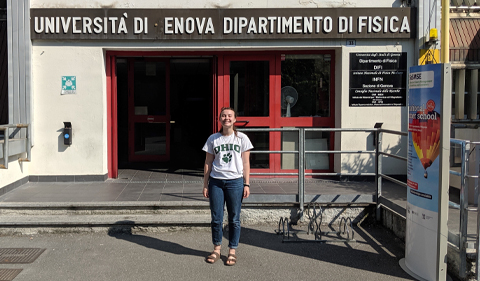By Miranda Carver
[B.S. Physics, College of Arts & Sciences, Class of 2020]
I conducted research last summer in in Genoa, under the direction of Andrea Celentano, and at Ohio University with Dr. Kenneth Hicks, a professor in Physics & Astronomy. The National Science Foundation and my department sponsored my two-month internship. This work is ongoing during my senior year.
I am interested in a subatomic particle called a meson, which is intermediate in mass between an electron and a proton and transmits the strong interaction that binds nucleons together in the atomic nucleus. Specifically, I study a meson called the f2(1270) which is of interest because it is part of a spectrum of mesons, each having a unique mass. One of the goals of particle physics is to predict the spectrum of mesons from the fundamental theory of the strong force, called Quantum Chromodynamics, or QCD.
I am studying the very small parts of what makes up the universe. What makes this very difficult is these particles have a short lifetime therefore we need excellent particle detectors in order to observe their interactions. I obtained data for this experiment from a particle detector called CLAS, which it is a large acceptance spectrometer– meaning that it can detect particles over a large range of emitted angles. The CLAS detector is located at Jefferson National Laboratory, in Newport News, Virginia.
It is important to study particle physics to understand quark-quark interaction and to compare experimental results with the theoretical calculations based on QCD. I find particle physics fascinating because I am able to learn about what is happening on a subatomic level. It is astounding that scientists are able to build highly sensitive detectors that measure all the information we need to study a reaction at that level. Conducting research as an undergraduate at this level is a good way to find out what this specialization entails.




















Comments